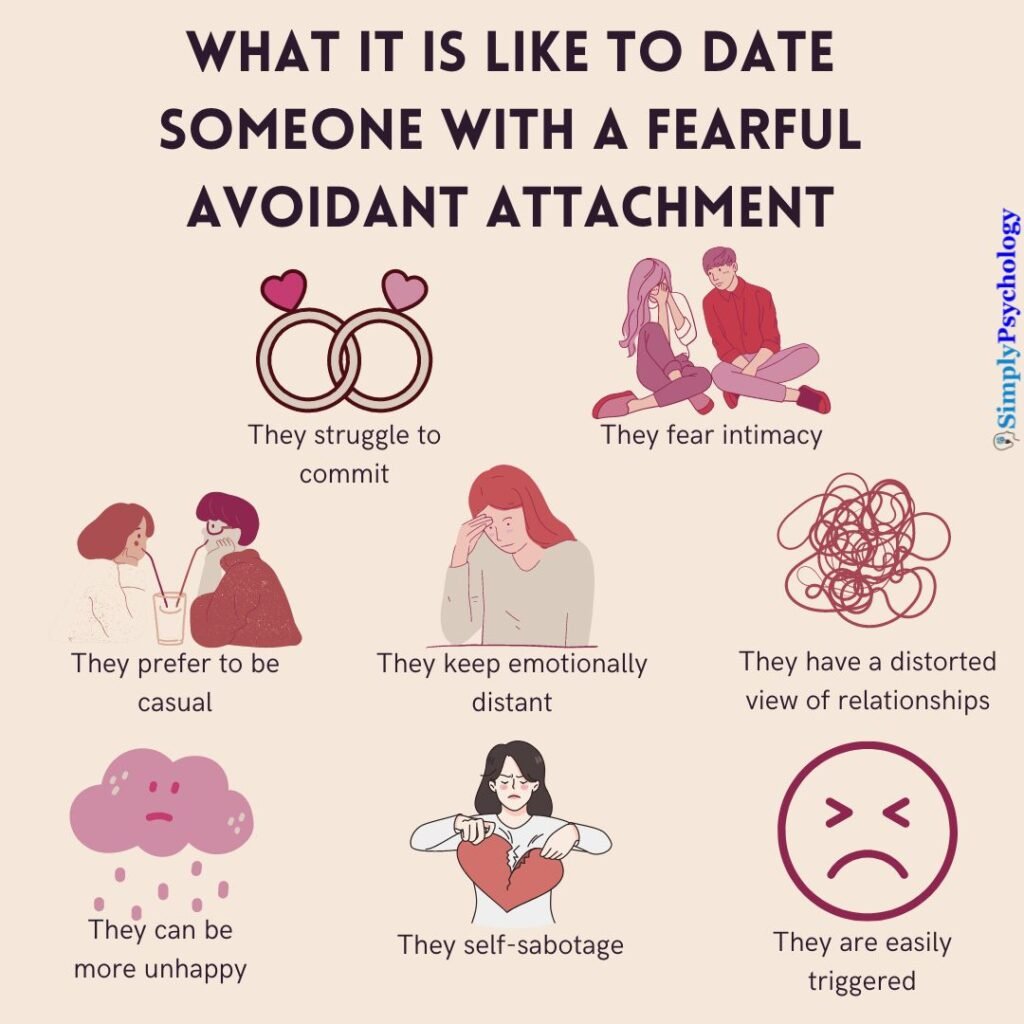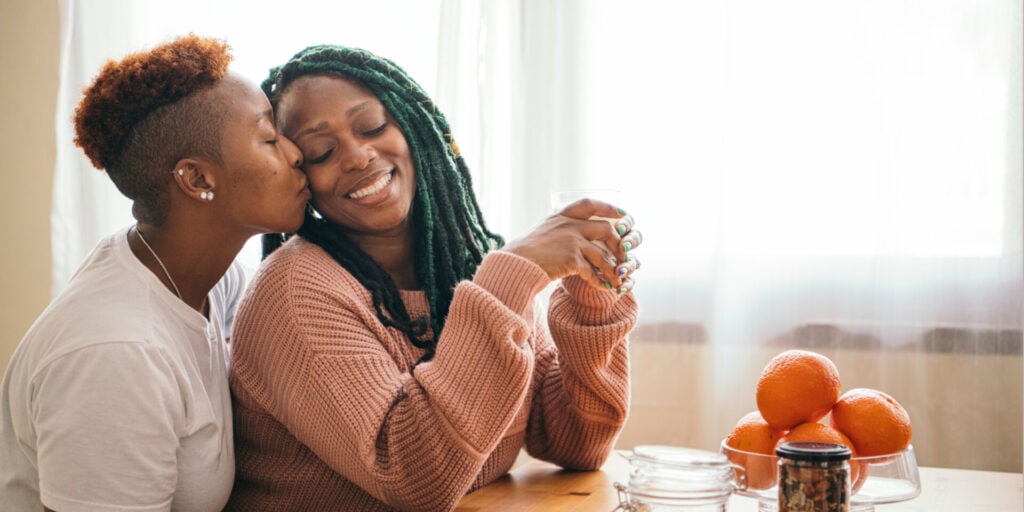On This Page:
A fearful-avoidant adult is characterized by a deep desire for emotional intimacy and connection, yet a simultaneous fear of rejection and getting hurt.
They may exhibit conflicting behaviors, oscillating between seeking closeness and pushing others away. They struggle with trust and may have difficulty fully opening up or committing in relationships, as they fear both being engulfed by intimacy and being abandoned or rejected by their partners.
Individuals with a fearful avoidant attachment style hold a negative model of self and also a negative model of others, fearing both intimacy and autonomy.
They may be socially withdrawn and untrusting of others. Therefore, it can be challenging to be the partner of someone who has this attachment style.

Dating a Fearful Avoidant
Below are some ways in which dating someone with a fearful avoidant attachment style can impact a relationship:

They struggle with commitment
Someone with a fearful avoidant attachment style may find it very difficult to commit to someone. They tend to both seek out connection and closeness while simultaneously trying to avoid getting into a serious relationship.
Their avoidant traits tend to arise when the relationship becomes more serious. This tends to trigger them and brings up past wounds. Often, when the relationship is committed is when a change becomes noticeable in a fearful avoidant partner.
They may be unable to fully trust that their partner will always be there for them, whether because of a core lack of self-worth, a lack of trust in others, or a combination of the two.
They are fearful of intimacy
Due to their deep-rooted distrust of others, someone with a fearful avoidant attachment may find it difficult to commit to someone.
They tend to desire connection while simultaneously pushing someone away when things become more serious. Becoming too close to a fearful avoidant can trigger their past wounds, and this is when significant changes in their behavior can be noticed.
They prefer being casual
Since they are afraid of trusting and getting close to someone, a person with a fearful avoidant attachment is happier remaining casual with romantic partners.
They may find themselves staying in the dating stage of the relationship for a prolonged period as this feels more comfortable for them. They can stay in casual relationships or relationships without labels, not because they want to, but because they are afraid of getting closer.
Often, someone with this attachment style prefers to have casual sex with people to fulfill their need for attention without having to commit. Favez and Tissot (2019) found that fearful avoidance is predictive of more sexual partners and greater sexual compliance for both men and women.
They keep emotionally distant
Someone with a fearful avoidant attachment may prefer to keep their partner at a distance to avoid getting too emotionally intense.
They may be reluctant to share too much of themselves or talk about deep topics as a way to protect themselves. If things get too deep, or if they are asked to share personal things, they may shut down rapidly.

They have a distorted view of what a relationship should be
Since it is common for those with a fearful avoidant attachment to have grown up in a household that is very turbulent and chaotic, they may believe that this is also what romantic relationships should be like.
If they are in a relationship with someone who is secure and calm, they may be suspicious. They may believe something is wrong and challenge their partner or create a problem to make the relationship more unsettled and familiar.
They are generally more unhappy
In a study examining the impact of attachment styles on romantic relationships, avoidant styles were associated with less frequent positive emotions and more frequent negative emotions in relationships (Simpson, 1990).
They self-sabotage
Someone with a fearful avoidant attachment may self-sabotage a good romantic relationship because they are afraid and feel unsafe.
They tend to hyperfocus on things that can go wrong in the relationship, even if there is nothing to worry about. They may blame or accuse their partner of things, threaten to leave the relationship, or test their partner to see if they get jealous. All these strategies may cause their partner to consider ending the relationship.
They can be easily triggered
A fearful avoidant may be hyper-aware of small changes in their partner, which can be a big trigger for them.
These triggers can include a change in voice, micro-expressions, a shift in body language, and lying. A fearful avoidant partner may gather information about all these minor changes and will perceive that their partner is either withholding information, not being loyal, or is doing something to break trust.
Once they have this idea in their mind, they can blow up or push their partner away in a way they think is protecting themselves, even if their partner has not done anything wrong.
How A Fearful Avoidant Shows Love
A fearful avoidant may show that they love you through the following:
- Making an effort to connect with you
- Expressing that they want to be intimate
- They become more comfortable showing their vulnerable side
- They will express that they want to feel more secure, or they make a conscious effort to be more secure.
- They talk about the future with you
- They discuss what they are insecure about and recognize that they need to work on this
Supporting a Fearful Avoidant
If you have a partner who has a fearful avoidant attachment style, there are some things you can do to support them:
Learn about their attachment style
Learning about attachment theory and getting to know your partner’s attachment style through research can be a good starting point for understanding them better.
Understanding your partner’s needs, struggles and triggers can help you to make sure you are communicating with them in a supportive way.
Reassure them
If your partner has a fearful avoidant attachment, they probably fear getting too close to you since they believe they will be abandoned eventually.
Reassuring your partner by being explicitly clear that you love them and have chosen to stay with them for a reason may help them to feel more secure.
While it can be tempting to get annoyed or argue when they express their distrust of you, try to approach the situation with comfort and support instead.
Build their confidence in the relationship by doing things for them that prove your trust and that you can be a secure figure for them in their life.
Foster healthy communication
Unhealthy communication, such as criticizing, blaming, or complaining, can reinforce to your partner that you are going to hurt them eventually. Communicating through blaming often leads to the other person being defensive and choosing not to listen to what your needs are.
Instead, communicate your needs to your partner concisely, so there is little confusion. Your partner should know that you deserve to be respected and that you have your own boundaries.
Explain to them that you will support them as best as you can but also that there are things that you will not tolerate. It is important to look out for your own mental health, so if your partner is acting in a toxic way, this should be called out calmly and directly.
Try to work on becoming more open in your communication if this is something you struggle with. If you are someone that does not share much, this can lead a fearful avoidant partner to make negative assumptions about what you are keeping to yourself.
Practicing opening up a bit more can help clear up some uncertainties your partner has.

Listen
Listening can be extremely important to a partner with a fearful avoidant attachment style since they may have grown up in a household where their voice was not listened to.
Be open to hearing about your partner’s feelings and issues, however they are being expressed. Don’t try to fix the problems they come to you with unless they specifically ask you for advice. Instead, listen to understand and be someone they can come to when they need to unload.
Be reliable
Fearful avoidant partners have a deep fear and expectation that they are going to be disappointed by others.
You can help to break this unhelpful train of thought for your partner by becoming a reliable figure in their life. If you make promises and commitments, make sure you stick to them. If these are broken, this feeds into the fearful avoidant’s insecurities and can cause them to pull away from you.
The more reliant you are, the more your partner will trust and see you as a source of security and safety.
Work towards growth together
It may be the case that you both need to compromise for the relationship to work. You may need to work together to tackle the issues you have to make the relationship more secure. This may especially be the case if you yourself identify with one of the insecure attachment styles.
If you need extra support, you can consider going to individual or couple’s therapy, where a skilled therapist can help you both grow together as a couple.
Responding to a Fearful Avoidant
If you see your fearful avoidant partner pulling away from you, there are some ways in which you can respond:
Don’t chase them
If you pursue someone who is clearly indicating that they need space, they will likely pull away even more or even turn hostile.
Instead, reassure your partner that you will be there for them when they are ready to communicate with you.
Don’t take it personally
While it is tempting to get upset and frustrated when someone is pulling away, try not to take this personally. Often, the person pulling away is seeking distance as a form of self-protection, and it is not always about you.
It is important to remember that if they are being critical of you, they are often more critical of themselves and will need support around tackling this.
Be mindful of how you express strong emotions
No one likes to be yelled at, and emotional expressions delivered intensely often overwhelm avoidants. This is likely to make them pull away from you even more since it is triggering their attachment style.
Try to remain calm and express your needs and emotions in a way that is honest and open but in a healthy, gentle manner.
Allow them their independent lifestyle
It is necessary to realize that no partner can fulfill all our needs. Your partner may feel that you are too clingy if you want to do everything with them, and this could cause them to pull away even more.
It is important to have your own interests and spend time apart while making sure to come back to each other afterward. Being self-sufficient shows your partner that you are not overly dependent on them, which is something they can fear.
Frequently Asked Questions
How do you communicate with a fearful avoidant person?
While it may be tempting to argue with someone who has a fearful avoidant attachment when they are trying to self-sabotage their relationship, this is not a productive way to communicate.
When you notice them blaming or accusing you when there is nothing to be concerned about, this usually means their attachment style is being triggered, and they are fearful of things getting more intimate.
Approach conversations with them with openness and understanding. Gently reassure them and encourage them to communicate clearly. Ask them what needs are not being met and how you can help them achieve this.
Can a fearful avoidant person fall in love?
While a fearful avoidant person may be more prone to breaking romantic connections because of their own fears and insecurities, they can fall in love and develop a more secure attachment.
This is often more possible when they are in a relationship with someone who is securely attached and is understanding of the struggle the fearful-avoidant person has.
Is couples therapy or counseling beneficial for couples where one partner has a fearful-avoidant attachment style?
Yes, couples therapy or counseling can be highly beneficial for couples where one partner has a fearful-avoidant attachment style.
It provides a supportive and structured environment to explore underlying fears, improve communication, and develop secure attachment patterns.
Therapists can help the fearful-avoidant partner understand their attachment style while assisting both partners in fostering empathy, trust, and emotional intimacy.
Through guided interventions and techniques, couples therapy can build a stronger foundation and navigate the challenges associated with a fearful-avoidant attachment style, leading to healthier and more fulfilling relationships.
References
Brennan, K. A., Clark, C. L., & Shaver, P. R. (1998). Self-report measurement of adult attachment: An integrative overview. In J. A. Simpson & W. S. Rholes (Eds.), Attachment theory and close relationships (p. 46–76). The Guilford Press.
Brennan, K. A., & Shaver, P. R. (1995). Dimensions of adult attachment, affect regulation, and romantic relationship functioning. Personality and Social Psychology Bulletin, 21 (3), 267–283.
Caron, A., Lafontaine, M., Bureau, J., Levesque, C., and Johnson, S.M. (2012). Comparisons of Close Relationships: An Evaluation of Relationship Quality and Patterns of Attachment to Parents, Friends, and Romantic Partners in Young Adults. Canadian Journal of Behavioural Science, 44 (4), 245-256.
Fraley, R. C., & Roisman, G. I. (2019). The development of adult attachment styles: Four lessons. Current opinion in psychology, 25, 26-30.
Hazan, C., & Shaver, P. (1987). Romantic love conceptualized as an attachment process. Journal of Personality and Social Psychology, 52 (3), 511–524.
Main, M., Kaplan, N., & Cassidy, J. (1985). Security in infancy, childhood and adulthood: A move to the level of representation. In I. Bretherton & E. Waters (Eds.), Growing points of attachment theory and research. Monographs of the Society for Research in Child Development, 50 (1-2), 66-104.
Simpson, J. A. (1990). Influence of attachment styles on romantic relationships. Journal of personality and social psychology, 59 (5), 971.

